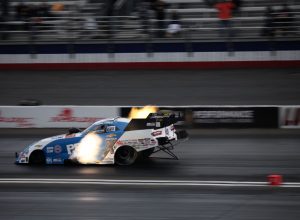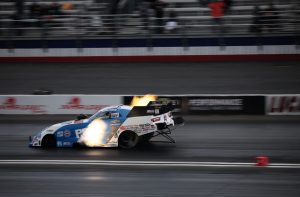
The dragster is a machine-thing whose principal asset resides in its extreme speed: it brutally accelerates over a very short route, attaining the record of more than 500 kph. Connected to the danger incurred by its driver, its mythology looms large in certain milieus Paul Ardenne studies as an anthropologist of art in our age that is tempted by degrowth but, at its other end, by performance and acceleration.
Laurence Bertrand Dorléac Paul Ardenne
What? Dragsters?
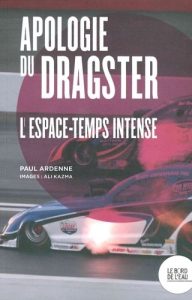
Dragsters? What Does the Encyclopedia Say?
Dragster refers to a mechanical acceleration sport for two- and four-wheeled vehicles. From a standing start, the goal is to take the least time possible to travel a distance of 1/4 mile (402 meters), 1/8 mile (201 meters) or, since 2012, 1,000 feet (305 meters).[1]
As a sport, the “dragster” is also a machine, a vehicle technically designed for acceleration:
A two- or four-wheeled sports vehicle with a several hundred or several thousand horsepower motor, the dragster, using an improved fuel, is to travel short distances as rapidly as possible from a standing start. In 10 to 3 seconds, it attains speeds that can be greater than 500 kph.[2]
The dragster is thus both a sport and a machine—with, to embody this sport and this machine, engineers, mechanics, drivers, competition organizers, and an audience of fans who follow these competitions. Taken together, these elements engender a culture, a civilizational fact, the civilization of acceleration as a way of life.
Dedicating one’s life to acceleration is the dragster’s mission.

Drag race in Pomona, California, January 2018. Courtesy Ali Kazma (DR).
Acceleration is a mechanical phenomenon: a body picks up speed. It is a sensation: living the transition from lesser mobility to increased mobility. It is a vital experience: one leaves one position and shoots oneself into orbit in order to experience another. It is, also, a departure, a wrenching moment, the dynamic projection of our bodies into space. Rejecting orderly movement, acceleration constitutes an intense way of activating human life.
As the dragster allows its most extreme expression, this leading lord of acceleration raises itself to the rank of essential machine—a mechanical one, certainly, but in an existential way. Machines can be idiotic and are so, for the most part. Slaves to a demand, they render a service in order to assist in, to facilitate, production or certain of life’s gestures. In itself, the dragster is idiotic. It is a machine, like so many others—an engine for traveling about that is designed to move the body of a driver and to activate our gazes as spectators who follow its course over the contained space of the “drag strip.”
Nonetheless, beyond its idiocy the dragster is more than a simply useful object. It is also, instead of a “thing,” an emotional companion.
Passing from an immobile state to the most rapid possible state of mobility is an age-old human obsession. At all times, humans have sought to move as quickly as possible, to leave behind their status as immobile beings, set down somewhere upon the Earth’s surface, in order to attain the status of moving, traveling beings—traveling, if possible, with exceptional speed, covering the distance in a flash, through one’s capacity to assert space over time and time over space.
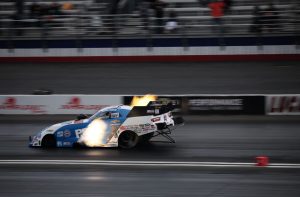
Drag race in Pomona, California, January 2018. Courtesy Ali Kazma (DR).
In this highly anthropological undertaking, the dragster is the most appropriate vector imaginable. Whether it has two, three, or four wheels, this mechanical engine born in the twentieth century is designed for acceleration and acceleration alone. The dragster involves insane bursts of speed, despite its journey along a straightaway track that has been reduced to a minimum (a few hundred meters, at the very most). For the driver, the dragster yields sensations that are at once brutal and complex. They are brutal, for, during the “run,” the body of the drag racer receives in a few seconds up to 6Gs or more—six times the load of his own weight. And such sensations are complex, for dragster competitions aim at an objective that is as heroic as it is improbable: cancelling the time elapsed while retaining only the space gained. This is an automatically problematic challenge that involves a quest for an inaccessible absolute.
A Brief Voyage
The space of a dragster competition—the “drag strip”—is eminently simple: a track with a starting line. In its earliest days, the track was made of concrete. Endowed since the 1960s most of the time with a tar track, such acceleration races generally were held on asphalt coatings with high levels of adherence, ones that “stick.”
Let us view this drag strip as the theatrical stage of the dragster universe. Spectators on either side have taken up their positions, standing behind barriers. Others, looking down from above, are seated in the stands. This human cluster is concentrated as close as possible to the starting line—as people would squeeze together en masse in an Italian-style theater, in the middle of the stalls, in order to be as close as possible to the stage and the actors. In order to get a better optical grasp of the show, the regulars, however, are more likely to take up a position at a distance from the race’s starting point: taking a step back better allows one to perceive the acceleration. Dragsters’ bursts of speed are such that the eyes of even those who frequent drag races most assiduously may be caught off guard and miss the show.
Every competition has its own space, its area of play. The chessboard—limited in scope, concentrated, and placed directly beneath one’s gaze—expresses the powerfully cerebral nature of that game of mental skill. In the case of the chessboard, there is no need for geographical deployment—indeed, ultimately no need at all for any space, properly speaking: the great chess player retains his game and that of his adversary within himself, imprinted there; he can play, as is said, “in his head.” The drag strip, on the contrary, spreads out in space, like the fields set aside for sports that, for the player to complete the game, involve his traveling across an extracorporeal territory, one that goes beyond his own body. Much may be learned about the nature of a sport just by studying the configuration of the perimeter of where the action takes place. The drag strip, the dragster’s field of play, is one of those sites that is of deceptive simplicity. In appearance, it is a quite ordinary site, and yet it is a space in a state of tension—as are, too, the track for the 100-meter sprint and that of the 110-meter hurdles. The simplicity of the game’s space, its compact character, and the optical concentration it allows surely express the intensity of the challenge and the violence of the competition among players, as in a ring. As a calculated space, a space contested in a flash, it is one to be conquered without even having the time to take a breath. In this exemplary setting of brief stakes and brisk engagements, brutality is de rigueur. In this game, failing to be brutal is automatically to lose out, to risk defeat.
A “More” Machine
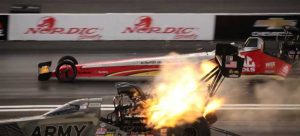
Drag race in Pomona, California, January 2018. Courtesy Ali Kazma (DR).
Whether it includes two, three, or four wheels (three-wheeled “trikes” nonetheless remain rare), the dragster is a more machine.
What do we mean by “a more machine”? It is a mechanism wherein excess is integral to its genetic makeup. There is internal excess: a dragster’s mechanics are designed in such a way as to yield maximum risk of a crash, that being assumed to be part of one’s lot. And there is external excess: surrounding a dragster in operation, the world itself is taken on a rough ride, forced to endure a tough time.
At the end of the 1940s, in the euphoric and flippant atmosphere of the start of the “Long Boom” (which the French sociologist Jean Fourastié named Les Trente Glorieuses, the “Glorious Thirty Years,” this three-decade period, from 1945 to 1975, characterized by an unparalleled economic upturn), many young people had in their hearts a seminal desire for acceleration and its benefits. Deeply rooted in the body, this was a high-flying desire, a sublime one. More than anything else, that to which those young people aspired was the transcendence acceleration procured. Were they a majority? No. After World War II had reshuffled the deck of planetary power, what most adolescents and adults had in their heads was the idea of political revolution, that is, of overturning egotistical bourgeoisies and sharing the wealth. They sought to abolish the old systems inherited from the first phase of industrial capitalism and Western colonization. For kids in a hurry, those were great battles that, like a whirlwind, sucked up youths’ appetites for a better, less inhuman world. In Europe, in China, in Africa, in India, in Cuba, and so on, the time was ripe for new talents to “change life/transform the world,” as it was called in a slogan that federated Karl Marx and Arthur Rimbaud with Franz Fanon. But, come on! Is it really reasonable to prefer acceleration to revolution? Isn’t that more or less contemptible? Is not the dragster first and foremost a form of entertainment, a hobby? Is dragster racing but a sport? Is it more than an impoverished form of what Blaise Pascal called “entertainment” [divertissement], indulgence in which cheaply diverts [détourne] you from the necessities of life, the ponderousness of existence, its genuine challenges?
To each his own—to each his own choices and his own revolution. In the spirit of the pioneers of drag racing, would they not head off toward the consensus position, with the cult of acceleration as a lifestyle seen as being of equal value to other existential choices—including, that is, from the political standpoint? Does the revolutionary Marxist long for the liberation of human beings and does the anti-imperialist activist long for the liberation of colonized peoples? Let us wager that the drag racer, like those champions of freedom, is also a liberator, in his own way. What is the vital project of the drag racer if not to break the chains of inertia? What is his objective if not to project his body into a space released of all fetters? What is the sacred goal he sets for himself if not to magnify, if not to enlarge, if not to extend, in his own singular, striking, radical and thundering way, the wings of freedom?
Is There a Future for Drag Racing?
At the time of the writing of these lines, that of “global warming,” and in a world punch drunk from all sides by reports of known environmental disaster, the practice of drag racing has indisputably been rendered vulnerable. Because of their pollution, combustion machines do not receive good press. The global cultural trend is toward so-called alternative energies (wind power and solar heating), which man gathers in nature as one would pick flowers without cutting their stems. In times like these, the consensus view is running decidedly against petroleum products and waste. How is one now to promote interest in, and the very necessity of, a machine that, each second, consumes ten liters of a highly toxic and explosive fuel, that dispatches into the atmosphere, solely during the brief time of a “run,” several hundred cubic meters of carbon dioxide and kilograms of melted rubber—a machine that must be reconditioned each time after ten seconds of operation?
In the present guilt-inducing atmosphere, there is nothing surprising about the fact that, in the twenty-first century, drag strips are, in many places, little by little being emptied out of both their competitors and their spectators. In short, people’s mentalities are changing. Whoever wants to feel time in its density, whoever wants to feel space in its density will nevertheless find in the practice of drag racing an opportunity for fulfillment. There, one lives acceleration in an accelerated way. Drag racing is a major form of existence.
[1]http://fr.wikipedia.org/wiki/Dragster
[2]Definition drawn from the Larousse dictionary.
Bibliography
Montgomery, Don. Dragster and Funny Car Memories. No. 7. Southern California in the “Sixties.” Self published.
Sakkis, Tony. The Anatomy & Development of the Top Fuel Dragster. Osceola, WI: Motorbooks International, 1993. ISBN-10: 087938770X ISBN-13: 978-0879387709.
Welberry, Dan. Top Fuel Dragster Manual: The Quickest and Fastest Racing Cars on the Planet! Somerset, UK: Haynes Owners’ Workshop Manuals/Haynes Publishing Group, 2014. ISBN100857332651 ISBN139780857332653.
Holder of the teaching agrégation in History, a PhD. in Art History, a research and teaching professor (Arts, Amiens), and a collaborator in such journals as Art Press, Archistorm (France), and INTER (Canada), Paul Ardenne is the author of several works dealing with aesthetics today: Art, l’âge contemporain (1997), L’Art dans son moment politique (2000), L’Image Corps (2001), Un Art contextuel (2002), and Portraiturés (2003). His most recent publications are entitled Un Art écologique (2018) and Apologie du Dragster (2019). He is also a novelist as well as a curator of contemporary art. He has designed the following exhibitions: “Micropolitiques” (Grenoble, 2000), “Expérimenter le réel” (Albi-Montpellier, 2001 and 2002), and “Working Men” (Geneva, 2008), “Printemps de Septembre à Toulouse” (2012), “Courants verts. Créer pour l’environnement” (Paris, 2020), among others. Ardenne was one of the guest organizers for the “Force de l’art” exhibition at Paris’s Grand Palais in May-June 2006.
